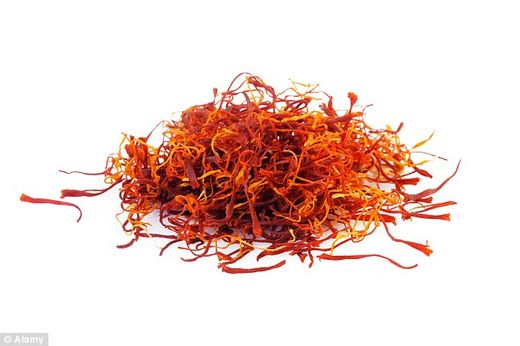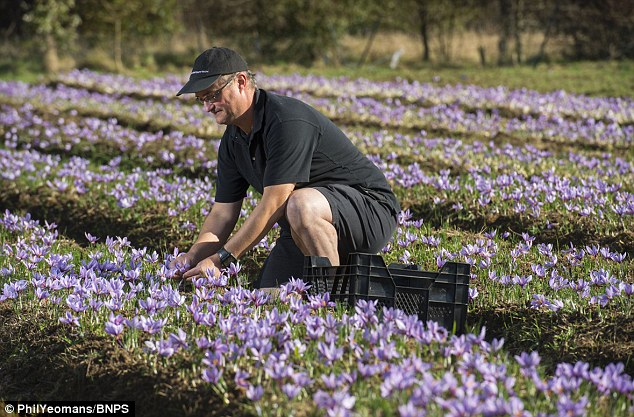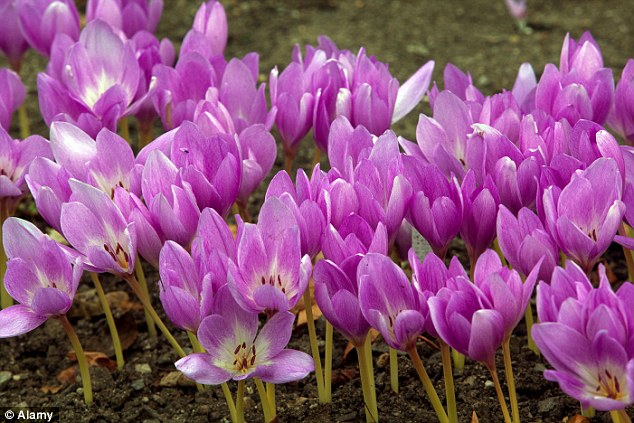
Farmer David Smale was inspired to start producing the spice after discovering a crocus plant in his Essex garden, and his produce is now being sold in prestigious London grocers Fortnum & Mason and Partridges.
Growing the spice was once a popular practice in Britain, but died out because the painstaking harvesting methods became too expensive to compete with cheap saffron imported from remote Iran and Kashmir.
Business is blooming: Farmer David Smale has brought saffron production back to England for the first time in 200 years, with his Essex farm in what was the heartland of saffron growing during Tudor times
However, Mr Smale has brought the practice back to Essex, and now tends to his precious crop at a top secret location close to Saffron Walden in what was the heartland of British production in Tudor times.
With a gram, 0.035 of an ounce, of the sought-after spice selling for up to £75, saffron is more expensive than gold because harvesting it is so laborious.

Mr Smale, who is Britain's only saffron grower, launched his business after finding success growing the crocus sativus flowers in his back garden.
Growing enterprise: Mr Smale, who is Britain's only saffron grower, launched his business after finding success growing the crocus sativus flowers in his back garden
'I've always wanted to grow something and one day I had a mad idea that I would grow saffron,' said the 50-year-old.
'I live in Essex and my family has a connection to Cornwall, two places that were big on saffron production centuries ago.
'I looked into who was growing saffron and to my surprise I found there was no-one doing it.
'I was told the practice had died out a few hundred years ago which I thought was ridiculous so I decided to give it a go.
'The first year I grew the crocuses in my back garden and just built my stock up from there.
'For the first few years I had some successes and some disasters but there was no-one to turn to for advice - I was learning as I went along.

'The turning point came when I found a medieval text for growing saffron in the archives of the library at Saffron Walden,' he said.
'It dated back to the 1600s and confirmed everything I had learned so I knew I was doing it right.
'At first I had wanted to grow saffron just as a hobby, and so someone in Saffron Walden was growing it, but it went so well that I decided to turn my hobby into a commercial business.
'Each year we get bigger and bigger and by next season we are hoping to be able to employ people. To have that industry back in Essex after all these years is amazing.'
Mr Smale runs a geophysics consultancy as well as tending to his crop of crocuses, which get planted in summer then harvested in late autumn.
Tens of thousands of flowers have to be hand picked just at the right moment then dissected to remove the three red stigmas from each one.
The strands are dried on racks for 24 hours then put into storage containers ready for packing.
A 0.2g packet of David's saffron sells in Fortnum & Mason for £15 and it regularly comes out top in taste tests.
'This year has been a fantastic harvest because of the hot dry summer,' he said.
'We've had tens of thousands of flowers to pick but you still only get about 90 grams of saffron from that.
'It sounds ridiculously small but we sell it in 0.2g packets so it goes a long way.
'Everything has to be picked by hand - you can't mechanise it. Once you pick the flowers you then have to dissect them to get the stigmas.
'You only get three stigmas in each flower and they have to be air-dried so the work involved is huge.
'These days saffron is more associated with exotic locations like Iran, Morocco and Spain but in the past English saffron has been by reputation the best in the world.
'Ours certainly comes out top in taste tests. It's sweeter and more honey-like than other varieties and I think that's down to the nutrients in the soil.
'We're lucky that there's a food revolution at the moment and people are prepared to pay a little bit more for quality produce made locally.
Such is the success of his company, English Saffron, that David is looking to upscale his output by 20 times next season.
He added: 'We moved into a new field this year which will become our centre for processing and we're looking to take on another field next season.
'We're talking about increasing our size dramatically by about 20 times.
'Saffron Walden was one of the world's major producers of saffron a few centuries ago and we're happy to be doing our bit to keep the tradition alive.'



Comment: Saffron has been traded and used for over four millennia. In addition to its use in dyeing textiles and cooking, it has also been found to have numerous health benefits. Scientists have found the compounds in saffron play key roles in preserving eyesight and boosting immunity by helping white blood cells to mature, and has been shown to be capable of inhibiting tumors.
Saffron Could Save Your Eyesight
What is Saffron Good For?